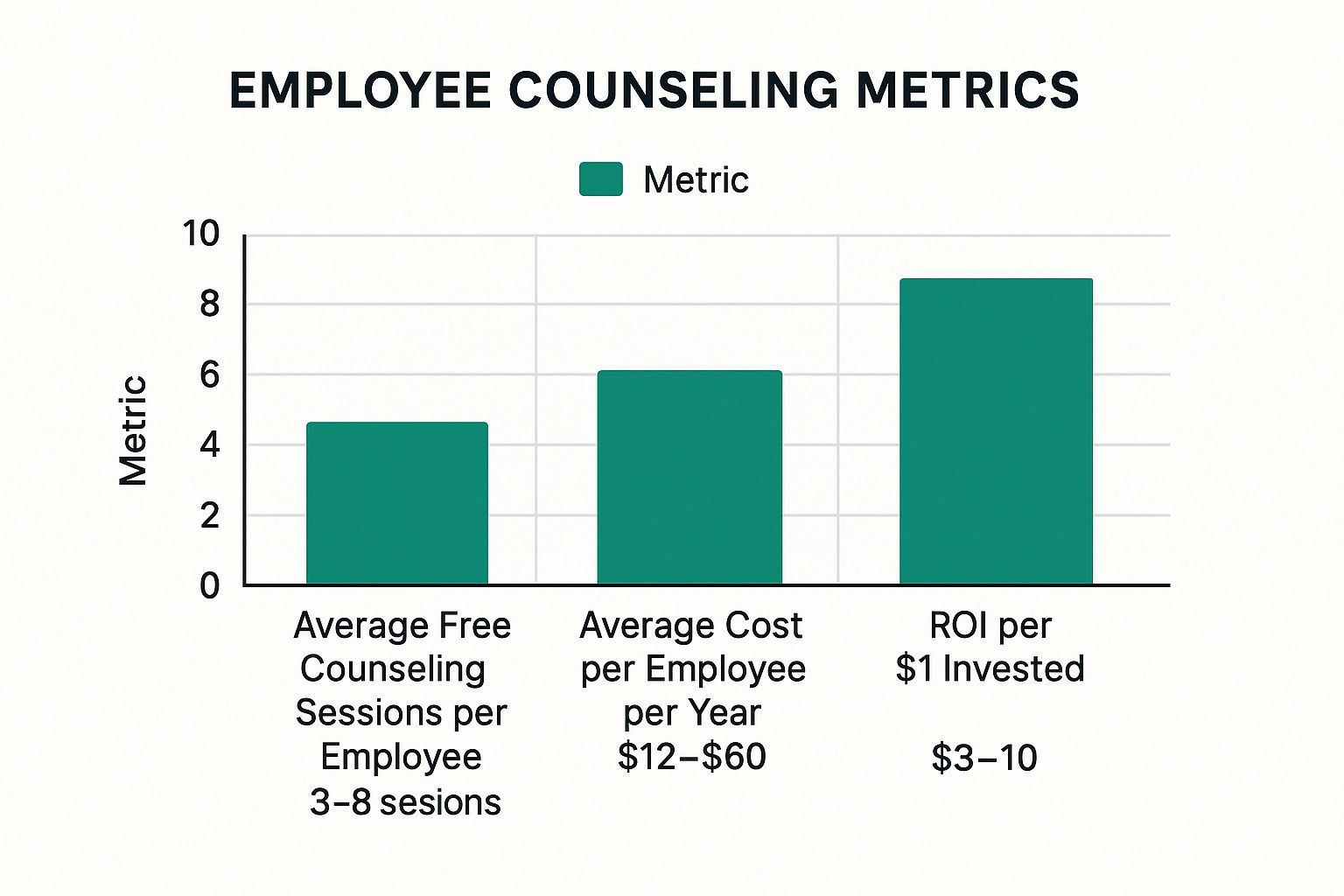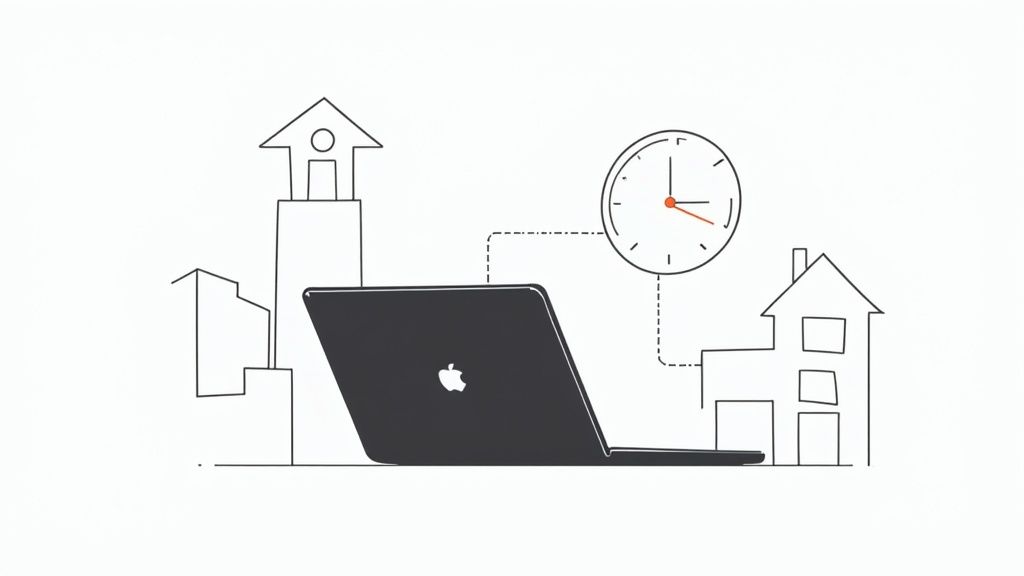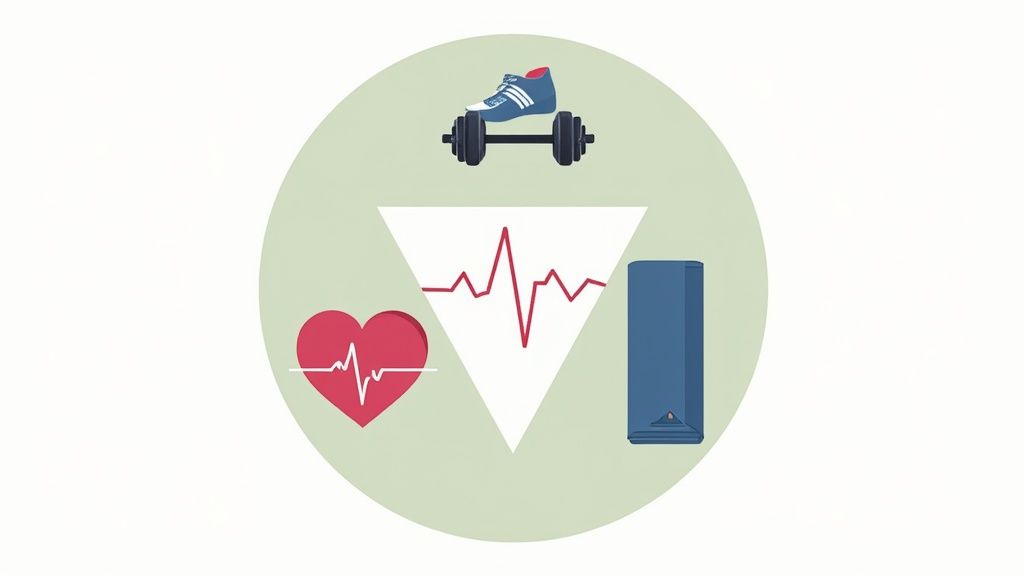
10 Effective Employee Wellness Program Ideas for 2025
Posted by Robin on 11 Oct, 2025 in
In today's competitive landscape, attracting and retaining top talent requires more than just a competitive salary. A truly supportive work environment prioritises the holistic health of its team members, moving far beyond outdated perks. Gone are the days when a simple fruit bowl or a discounted gym membership constituted a meaningful wellness strategy.
Modern, effective employee wellness programs are comprehensive, multi-faceted, and address everything from mental health and financial stability to social connection and physical fitness. Forward-thinking organisations recognise that employee wellbeing is a strategic imperative, directly impacting productivity, engagement, and retention. Investing in a robust wellness programme is no longer a "nice-to-have"; it is a critical component of a sustainable business model.
This guide moves beyond generic advice to provide a detailed look at 10 powerful and practical employee wellness program ideas you can implement to build a resilient, engaged, and thriving workforce. We will delve into specific strategies across the four core pillars of wellbeing - mental, physical, financial, and social - providing actionable tips and real-world examples.
You will discover how to craft a tailored programme that not only helps reduce absenteeism and healthcare costs but also cultivates a culture where every employee feels valued and empowered to perform at their best. From implementing flexible working arrangements to offering financial literacy workshops, the following sections provide the insights needed to create a wellness initiative with genuine, lasting impact. Let's explore the ideas that will revolutionise your approach to staff wellbeing.
1. Mental Health Support and EAP (Employee Assistance Programmes)
Prioritising mental health is a cornerstone of any effective employee wellness programme. Employee Assistance Programmes (EAPs) offer a structured, confidential framework for supporting staff through personal and work-related difficulties. These programmes provide a critical lifeline, offering access to professional counselling, therapy sessions, and stress management resources.
A robust EAP typically includes 24/7 hotlines, virtual or in-person therapy, and guidance for challenges like anxiety, depression, and significant life transitions. For example, Starbucks famously extended its EAP to provide free therapy sessions for all its employees, including part-time staff, showcasing a commitment to accessible care. Similarly, Unilever’s global mental health initiative demonstrably improved wellbeing scores across its 150,000-strong workforce. For organisations looking to support staff facing complex challenges, it's vital to ensure your EAP can connect them with specialised resources like Mental Health and Addiction Services.
Implementation and Best Practices
To successfully integrate an EAP, focus on destigmatising its use and building trust.
- Promote Relentlessly: Use multiple channels like email, team meetings, and internal newsletters to regularly remind employees of the available EAP benefits and how to access them confidentially.
- Train Leadership: Equip managers to recognise signs of distress and burnout. Training should focus on how to compassionately guide employees towards the EAP without overstepping professional boundaries. Understanding how to manage and prevent staff exhaustion is a key leadership skill; you can find more guidance in our article on overcoming burnout in the workplace.
- Guarantee Confidentiality: Emphasise that EAP usage is completely confidential. This is the single most important factor in encouraging employees to seek help.
- Integrate Mental Health Days: Formalise mental health support by including specific mental health days within your paid time off (PTO) policy.
This bar chart visualises the typical investment and return associated with implementing an EAP.

The data highlights that for a modest annual per-employee cost, organisations can achieve a significant return on investment, making EAPs a financially sound and ethically responsible choice.
2. Flexible Work Arrangements and Work-Life Balance Initiatives
Fostering a healthy work-life balance is a fundamental pillar of modern employee wellness. Flexible work arrangements empower staff to tailor their schedules and locations to better integrate professional responsibilities with personal life. These initiatives move beyond the traditional 9-to-5 model to include remote work, flexible hours, compressed workweeks, and job sharing, directly addressing a primary source of employee stress.

This approach grants employees autonomy, which is proven to boost morale, reduce burnout, and increase productivity. For instance, Microsoft's hybrid workplace guide allows most staff to work from home up to 50% of the time, enhancing job satisfaction. Patagonia is another excellent example; its longstanding flexible schedule programme contributed to an employee turnover rate of just 4%, far below the industry average. Dell's "Connected Workplace" programme also sees over 60% of its global team benefiting from flexible arrangements, showcasing scalability. These successful models demonstrate that flexibility is a key component of a thriving company culture.
Implementation and Best Practices
To successfully implement flexible work arrangements, organisations must build a foundation of trust and clear communication.
- Establish Clear Protocols: Define expectations for communication, availability, and collaboration. Ensure everyone understands core working hours and response timeframes, regardless of their location.
- Invest in Technology: Equip teams with the necessary collaboration tools (like Slack, Microsoft Teams) and provide stipends for home office equipment to create an equitable and productive environment for all.
- Focus on Outcomes: Shift performance metrics from hours worked to results achieved. This trusts employees to manage their time effectively and deliver high-quality work, fostering a sense of ownership.
- Set Firm Boundaries: Actively discourage an 'always-on' culture by establishing clear guidelines around after-hours communication. Encourage employees to fully disconnect during their personal time. For help structuring these conversations, explore these flexible working request example templates.
3. Physical Fitness and Gym Membership Programmes
Encouraging physical activity is a foundational element of successful employee wellness programme ideas. Initiatives like subsidised gym memberships, on-site fitness facilities, and group exercise classes address the direct link between physical health, mental wellbeing, and job performance. These programmes provide employees with the resources and motivation to stay active, leading to increased energy levels, reduced stress, and lower absenteeism.

Many leading companies demonstrate the powerful impact of these initiatives. For example, Johnson & Johnson's comprehensive wellness and fitness programmes reportedly saved the company over £190 million in healthcare costs over a decade. Tech giant Asana provides its employees with ClassPass memberships, resulting in an impressive 89% participation rate. Similarly, outdoor retailer REI champions an active lifestyle by offering two paid hours per week, known as "recess," for employees to exercise outdoors. These examples highlight how investing in physical fitness yields a strong return through improved employee health and engagement.
Implementation and Best Practices
To roll out an effective physical fitness programme, focus on accessibility, variety, and creating a supportive culture.
- Offer Diverse Options: Accommodate all fitness levels and interests by providing a range of choices. This could include partnerships with local gyms, subscriptions to platforms like Peloton Corporate Wellness, or organising group activities like walking clubs or yoga sessions.
- Prioritise Accessibility: Make it easy for employees to participate. If you have on-site facilities, ensure they have convenient changing rooms and showers. For remote or hybrid teams, virtual classes and fitness app subscriptions are excellent alternatives.
- Gamify and Reward: Introduce team-based fitness challenges with rewards to boost motivation and camaraderie. Celebrate participation and personal milestones, not just top performance, to create an inclusive environment.
- Integrate with the Workday: Encourage activity by promoting walking meetings or providing standing desks. Allowing flexibility for exercise during work hours shows a genuine commitment to employee wellbeing.
4. Nutrition and Healthy Eating Programmes
Fueling employees with nutritious food is a powerful way to enhance energy levels, cognitive function, and overall physical health. Nutrition and healthy eating programmes go beyond simply providing snacks; they create an environment that supports mindful eating habits through education, accessible healthy options, and expert guidance. These initiatives recognise that proper nutrition is a fundamental pillar of wellbeing, directly impacting productivity and preventing chronic health issues.
A comprehensive nutrition strategy can transform workplace culture. For example, Google’s famous "micro-kitchens" ensure healthy snacks and drinks are always within 150 feet of any employee, boosting both health and satisfaction. Similarly, Facebook offers free, nutritionist-designed meals in its on-campus dining facilities, removing the guesswork from healthy eating. Smaller companies can also make a significant impact; The Motley Fool provides healthy snacks and saw an impressive 80% participation rate in its voluntary nutrition programme.

Implementation and Best Practices
To build a successful nutrition programme, focus on positive reinforcement and accessibility.
- Survey and Customise: Start by surveying employees to understand their dietary preferences, allergies, and restrictions. Use this feedback to tailor your offerings.
- Educate and Empower: Host lunch-and-learn sessions with registered nutritionists or dietitians. Provide resources for meal preparation and planning to help employees build sustainable habits outside of work.
- Focus on Addition, Not Restriction: Create a positive food culture by adding appealing, healthy options rather than banning "unhealthy" ones. Clearly label nutritional information to help staff make informed choices.
- Include Everyone: Ensure remote and hybrid employees are included. Offer stipends for healthy meal delivery services or organise virtual cooking classes and nutrition workshops. Platforms like Foodsmart can offer personalised digital nutrition support for your entire team.
5. Financial Wellness and Education Programs
Financial stress is a leading cause of distraction and reduced productivity in the workplace. Implementing financial wellness and education programmes directly addresses this challenge by equipping employees with the tools, knowledge, and resources to manage their finances effectively. These programmes go beyond simple salary discussions to offer comprehensive support, including financial planning, debt management, and investment education.
A well-structured financial wellness initiative can significantly reduce employee anxiety and improve focus. For example, PwC's programme reached 90% of its workforce and successfully reduced financial stress by 35%. Similarly, Chipotle supports its staff with student loan repayment assistance up to $5,250 annually, directly alleviating a major financial burden for many. These initiatives, often powered by platforms like SmartDollar or LearnLux, demonstrate a clear commitment to an employee’s holistic wellbeing, fostering loyalty and engagement.
Implementation and Best Practices
To roll out an effective financial wellness programme, focus on accessibility, trust, and relevance.
- Ensure Confidentiality: Financial matters are deeply personal. Stress that all one-on-one coaching and use of financial tools are completely confidential to build the trust needed for employees to participate openly.
- Offer Tiered Learning: Cater to a wide range of financial literacy levels. Provide foundational workshops on budgeting and saving alongside more advanced sessions on investing and retirement planning.
- Address All Life Stages: Customise content for different career and life stages, from recent graduates managing student debt to older employees planning for retirement.
- Partner with Professionals: Collaborate with certified financial planners to provide credible, unbiased advice. Ensure resources are accessible to all employees, including part-time and hourly workers.
- Measure Impact: Track success not just by participation rates but by measuring reductions in self-reported financial stress, which is a key metric for evaluating one of the best employee wellness program ideas.
6. Mindfulness and Meditation Programmes
Integrating mindfulness and meditation programmes offers employees powerful, science-backed tools to manage stress, improve focus, and enhance overall emotional wellbeing. These initiatives teach structured, practical techniques that help staff become more present and resilient. By offering guided meditation sessions, mindfulness workshops, and access to dedicated resources, organisations can cultivate a calmer, more focused, and emotionally intelligent workforce.
The impact of such programmes is well-documented. Google's pioneering 'Search Inside Yourself' programme has become a global model for corporate mindfulness. Similarly, Aetna reported a 28% reduction in stress levels and a productivity gain of $3,000 per employee after implementing its own mindfulness initiative. These examples demonstrate that mindfulness is not just a passing trend but a strategic investment in employee health and organisational performance, making it one of the most effective employee wellness programme ideas.
Implementation and Best Practices
To introduce mindfulness successfully, prioritise accessibility, consistency, and a secular, science-based approach.
- Offer Multiple Entry Points: Provide a mix of live guided sessions, on-demand audio resources via apps like Headspace or Calm, and quiet rooms for individual practice. This caters to different comfort levels and schedules.
- Keep it Secular and Practical: Frame mindfulness as a mental 'workout' focused on concentration and stress reduction, avoiding spiritual or religious connotations that might alienate some employees.
- Encourage Leadership Participation: When leaders actively participate in sessions, it signals organisational commitment and helps destigmatise the practice.
- Integrate into the Workflow: Start meetings with a one-minute breathing exercise or introduce "mindful moment" reminders to help embed the practice into the daily routine. Our guide on top tips for wellness at work offers more ideas for seamless integration.
- Measure Engagement, Not Outcomes: Focus on participation rates and qualitative feedback rather than trying to measure individual stress reduction, which can feel intrusive. The goal is to provide a resource, not enforce a result.
7. Preventive Health Screenings and Biometric Programmes
Offering preventive health screenings is a powerful way to empower employees to take control of their physical wellbeing. These programmes provide regular, confidential health assessments and biometric measurements, such as blood pressure, cholesterol, and glucose levels. The primary goal is to identify potential health risks early, allowing for proactive management and intervention before issues become more serious.
This approach moves beyond reactive healthcare, creating a culture that values and supports long-term health. For example, the American grocery chain Safeway's "Healthy Measures" programme successfully reduced its healthcare costs by 12% while improving employee health outcomes. Similarly, Michelin's screening initiative identified significant cardiovascular risks in 20% of its participants, enabling crucial early treatment. These programmes demonstrate that investing in preventive care is a cornerstone of a robust employee wellness programme.
Implementation and Best Practices
To roll out a successful screening programme, the focus must be on accessibility, confidentiality, and supportive follow-up.
- Guarantee Confidentiality: Strictly adhere to data protection regulations and ensure all health information is confidential. Clearly communicate that individual results will never be shared with management or influence employment status.
- Prioritise Accessibility: Offer on-site screenings during work hours to maximise convenience and participation. For remote or hybrid teams, consider providing vouchers for local clinics or at-home testing kits.
- Incentivise Participation, Not Results: Reward employees for taking part in the screening, not for achieving specific health metrics. This encourages engagement without penalising those with pre-existing or genetic health conditions.
- Provide Actionable Follow-Up: The true value of a screening is the action it inspires. Partner with wellness providers like WebMD Health Services or Virgin Pulse to offer health coaching, resources, and clear explanations of results, so employees know what steps to take next.
8. Social Connection and Team Building Programmes
Fostering strong social connections is a vital component of a holistic employee wellness programme, directly impacting mental health, engagement, and retention. Social connection and team-building initiatives are designed to combat workplace isolation and cultivate a sense of belonging through structured activities, employee-led groups, and community events. These programmes create opportunities for colleagues to interact on a personal level, strengthening relationships beyond day-to-day work tasks.
Strong social bonds are a hallmark of high-performing, resilient teams. Salesforce's renowned "Ohana" culture, which includes extensive Employee Resource Groups (ERGs) for over 42,000 members, has demonstrably improved belonging scores by 28%. Similarly, the remote-first company Buffer hosts annual virtual retreats to bring its global team together, reinforcing its culture and maintaining strong connections despite the physical distance. These examples show how intentional social programmes are powerful employee wellness program ideas that build a supportive community.
Implementation and Best Practices
To effectively build social connections, focus on inclusivity and genuine interaction rather than forced fun.
- Offer Variety and Choice: Provide a diverse range of activities that appeal to different personalities and interests, from book clubs and sports leagues to volunteer days and creative workshops. Participation should always be voluntary.
- Empower Employee-Led Groups: Actively support and fund employee-led initiatives and ERGs. These groups provide a natural way for staff to connect over shared interests, identities, and experiences.
- Bridge the Hybrid Gap: Intentionally include remote and hybrid workers in all social planning. Use tools like Donut for Slack to facilitate random "coffee chats" or platforms like Gather for creating engaging virtual social spaces.
- Allocate Resources: Dedicate a specific budget and allow company time for social activities. This signals that the organisation values relationship-building as a legitimate and important part of work.
- Measure Belonging: Track metrics related to loneliness and belonging through employee surveys to gauge the impact of your initiatives and identify areas for improvement.
9. Sleep and Fatigue Management Programmes
Recognising sleep as a critical foundation of health, sleep and fatigue management programmes provide education, resources, and supportive policies to combat workplace exhaustion. These initiatives directly address the widespread issue of sleep deprivation, which significantly impacts employee productivity, safety, and overall health. By promoting better rest, organisations can foster a more alert, resilient, and effective workforce.
These programmes range from providing physical rest spaces to incentivising healthy sleep habits. For instance, Google famously installed 'nap pods' in its offices to encourage short, rejuvenating rests. Taking a different approach, US-based health company Aetna offered a financial incentive, paying employees up to $500 annually for consistently getting at least seven hours of sleep. Similarly, Arianna Huffington championed this cause at The Huffington Post by installing nap rooms after her own experiences with burnout, a philosophy she later expanded upon with her company, Thrive Global.
Implementation and Best Practices
To successfully implement a sleep and fatigue management programme, the focus should be on creating a culture that genuinely values rest.
- Educate and Normalise: Start by educating employees on the profound impact of sleep on cognitive function, mood, and physical health. Use workshops and internal communications to normalise conversations about sleep without judgement.
- Create Quiet Spaces: Designate a dark, quiet room for employees to rest, meditate, or take a power nap during breaks. This physical space signals that the organisation supports rest.
- Protect Employee Downtime: Implement clear policies that limit work-related communications and notifications outside of standard working hours. This helps employees psychologically detach and recharge.
- Offer Flexibility: Where possible, provide flexible schedules to accommodate different chronotypes (natural sleep-wake cycles). This is particularly crucial for addressing the health risks associated with shift work.
- Lead by Example: Encourage leadership to model healthy behaviours by visibly taking breaks, respecting non-working hours, and speaking openly about the importance of rest.
10. Personal Development and Learning Programmes
Investing in personal and professional growth is a powerful employee wellness programme idea that boosts both individual wellbeing and organisational capability. Learning and development programmes offer structured opportunities for employees to acquire new skills, pursue educational goals, and receive career coaching, demonstrating a company's commitment to their long-term success. These initiatives nurture a culture of continuous improvement and intellectual curiosity.
Many leading companies have integrated learning into their core wellness strategy. Amazon's Career Choice programme, for instance, pre-pays 95% of tuition for courses in high-demand fields, regardless of their relevance to an employee's current role. Similarly, Starbucks offers full tuition coverage for bachelor's degrees through its partnership with Arizona State University, empowering its workforce to achieve significant personal milestones. These examples show that supporting employee growth creates a more skilled, engaged, and loyal team.
Implementation and Best Practices
To build a successful learning programme, focus on accessibility, relevance, and recognition.
- Offer Diverse Learning Formats: Cater to different learning styles by providing a mix of online courses (like those on LinkedIn Learning or Coursera for Business), in-person workshops, mentorship programmes, and self-paced resources.
- Provide Dedicated Learning Time: Where possible, allow employees to dedicate a portion of their working hours to development activities. This signals that learning is a valued and integral part of their role, not an extra burden.
- Connect Learning to Career Paths: Work with employees to link their learning goals to clear career progression pathways within the organisation. This helps them see a tangible return on their efforts and improves internal mobility.
- Celebrate Achievements: Formally recognise employees who complete courses, earn certifications, or acquire new skills. Highlighting these accomplishments in team meetings or newsletters reinforces a positive learning culture.
- Support All Interests: Include opportunities for personal interest learning alongside job-related training. Supporting a passion, whether it's learning a new language or a creative skill, contributes significantly to an employee's overall sense of fulfilment.
Employee Wellness Program Ideas Comparison
| Program Type | Implementation Complexity | Resource Requirements | Expected Outcomes | Ideal Use Cases | Key Advantages |
|---|---|---|---|---|---|
| Mental Health Support and EAP | Moderate to High | Counseling services, hotlines, trained therapists | Reduced absenteeism, improved productivity, early mental health support | Employees needing confidential mental health support | Confidential, holistic wellbeing, 24/7 access |
| Flexible Work Arrangements | Moderate | Technology for remote work, policy development | Higher satisfaction, retention, reduced commute stress | Roles adaptable to remote/flexible schedules | Increases work-life balance, attracts diverse talent |
| Physical Fitness and Gym Memberships | Moderate | Gym memberships, facilities, fitness programs | Reduced healthcare costs, improved energy and morale | Workplaces promoting physical activity | Improves mental health, team camaraderie |
| Nutrition and Healthy Eating Programs | Moderate | Healthy food provision, nutrition counseling | Improved energy, reduced chronic disease risk | Organizations focusing on overall health culture | Supports concentration and weight management |
| Financial Wellness and Education | Moderate | Financial experts, planning tools, workshops | Reduced financial stress, improved focus | All income levels, reducing financial anxiety | Low cost education, supports retention |
| Mindfulness and Meditation Programs | Low to Moderate | Meditation apps, quiet spaces, trainers | Reduced stress, improved focus, emotional resilience | Stress management, mental wellness focus | Low cost, science-backed, versatile practice |
| Preventive Health Screenings | High | Medical screenings, health coaching, data management | Early detection of health issues, cost savings | Workplaces emphasizing health risk management | Saves lives/costs, personalized health plans |
| Social Connection and Team Building | Moderate | Event planning, social groups, virtual platforms | Reduced isolation, improved belonging and collaboration | Building culture, combating loneliness | Enhances inclusion, creativity, retention |
| Sleep and Fatigue Management | Moderate | Education, nap rooms, coaching, flexible policies | Improved productivity, reduced errors and fatigue | Shift work, high-stress environments | Addresses overlooked health need, low-cost options |
| Personal Development and Learning | Moderate to High | Learning platforms, tuition reimbursement, coaching | Increased engagement, retention, skill growth | Employee growth, career advancement focus | Attracts talent, supports mobility |
Building a Healthier Future: Your First Step Towards a Better Workplace
Investing in employee wellbeing is no longer a fringe benefit or an optional perk; it has become a strategic necessity for modern organisations aiming for sustainable growth and a thriving culture. The comprehensive list of employee wellness program ideas detailed in this article, from robust Mental Health Support and Flexible Work Arrangements to Financial Education and Social Connection initiatives, provides a holistic blueprint for fostering a healthier, more engaged workforce.
The journey towards a truly supportive workplace doesn't require a simultaneous, large-scale launch of every programme mentioned. Instead, the most successful strategies are born from a deep understanding of what your employees truly need and value. The power lies in taking a tailored, phased approach.
From Ideas to Impact: Your Action Plan
Transitioning from reading about these concepts to implementing them is the most critical step. The key is to be strategic, intentional, and responsive to your team's feedback.
- Start with a Survey: Before investing time and resources, gather direct feedback. Use anonymous surveys to ask your employees what areas of wellbeing they are most concerned about. Is it financial stress, burnout, or a desire for better physical health options? Let their answers guide your priorities.
- Form a Wellness Committee: Create a volunteer group of employees from different departments and levels of seniority. This committee can champion initiatives, gather ongoing feedback, and ensure the programmes feel authentic and employee-driven, rather than a top-down mandate.
- Launch a Pilot Programme: Instead of a company-wide rollout, select one or two high-impact, low-cost employee wellness program ideas to pilot with a specific department. A mindfulness challenge or a financial literacy webinar are excellent starting points. This allows you to work out any issues and build momentum.
- Measure and Adapt: A wellness strategy is not a "set it and forget it" initiative. It must evolve. Regularly tracking the impact of your programmes is essential. By effectively measuring employee satisfaction, you can gather invaluable data on what's working and what isn't, allowing you to refine your approach and demonstrate a clear return on investment.
The Foundational Role of Rest and Recovery
Underpinning all these initiatives is a fundamental, non-negotiable principle: the right to rest. A company can offer unlimited yoga classes and healthy snacks, but if employees feel they cannot take their annual leave without facing administrative hurdles or a mountain of work upon their return, burnout is inevitable.
This is where operational efficiency meets wellbeing. A streamlined, clear, and fair system for managing holiday and other absences is not just an HR function; it is a core component of your wellness strategy. It signals that you trust your employees and actively encourage them to disconnect and recharge, which is vital for long-term mental and physical health.
By thoughtfully curating a selection of employee wellness program ideas that resonate with your unique workforce, you are making a powerful statement. You are communicating that you see your employees as whole people, not just workers. This commitment to their wellbeing is the ultimate investment in your organisation's most valuable asset. It is a commitment that will be repaid tenfold in loyalty, innovation, productivity, and the creation of a workplace where people genuinely want to be. Your journey to a healthier, happier, and more successful organisation starts now.
A crucial part of any wellness strategy is ensuring employees can easily take the time off they need to rest and recharge. Leavetrack simplifies absence management, eliminating the administrative friction that causes stress and prevents proper work-life balance. Discover how Leavetrack can become a foundational tool in your organisation's commitment to employee wellbeing.
